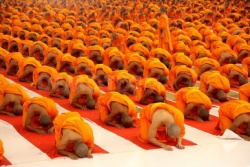Different degrees of No-Self
I was trained in this 3 aspects:
1. The experience
2. The realization
3. and the View
I will start with 'experience'. There are different experiences in relation to 'no self':
1. Impersonality.
This is the case when practitioners experienced that everything is an expression of a universal cosmic intelligence. There is therefore no sense of a personal doer... rather, it feels like I and everything is being lived by a higher power, being expressed by a higher cosmic intelligence. But this is still dualistic – there is still this sense of separation between a 'cosmic intelligence' and the 'world of experience', so it is still dualistic.
There is also a very important realization - the realization of Pure Presence or Consciousness or Beingness or Existence as being one's true identity. There is an irrefutable undeniable insight into the luminous essence of mind. Actually self-realization is not related to impersonality in the sense that impersonality can be experienced with or without self-realization, however a self-realized person would progress his experience in terms of impersonality. Nevertheless dualistic tendencies are strong and awareness is seen as an eternal witnessing presence, a pure formless perceiving subject. A true experience is being distorted by the mind's tendency at projecting duality and inherency (to things, self, awareness, etc)
2. Non-dual into One Mind.
Where subject and object division collapsed into a single seamless experience of one Naked Awareness.
3. No-Mind
Where even the naked Awareness is totally forgotten and dissolved into simply scenery, sound, arising thoughts and passing scent.
4. Sunyata
My experience here is still at the beginning phase. It is when the 'self' is completely transcended into dependent originated activity. The play of dharma.
Next is the 'Realization'. Having an experience of witnessing, or a state of pure presence, is not the same as having attained self-realization - in that case the practitioner can be said to have an experience, but not insight/realization. Having an experience is not the same as having a realization... for example, you may have a temporary experience where the sense of separation between experiencer and experience suddenly and temporarily dissolves or there is the sense that subject and object has merged... temporarily. This is not yet the realization of non-duality... the realization that separation has been false right from the beginning... there never was separation.
Hence having non-dual samadhis are *not* enlightenment... why? The realization that there never was separation to begin with, hasn't arisen. Therefore you can only have temporary glimpses and experiences of non-dual... where the latent dualistic tendencies continue to surface... and not have seamless, effortless seeing.
And even after seeing through this separation, you may have the realization of non-dual but still fall into substantial non-duality, or One Mind. Why? This is because though we have overcome the bond of duality, our view of reality is still seeing it as 'inherent'. Our view or framework has it that reality must have an inherent essence or substance to it, something permanent, independent, ultimate. So though everything is experienced without separation, the mind still can't overcome the idea of a source. The mind kept coming back to a 'source' and is unable to break-through and find the constant need to rest in an ultimate reality in which everything is a part of... a Mind, an Awareness, a Self.... what this results is a subtle tendency to cling, to sink back to a ground, a source, and so transience cannot be fully appreciated for what it is. It is an important phase however, as for the first time phenomena are no longer seen as 'happening IN Awareness' but 'happening AS Awareness' – Awareness is its object of perception, Awareness is expressing itself as every moment of manifest perception.
However, there is still a constant referencing back to the One Awareness. Until you see that the idea itself is merely a thought, and everything is merely thoughts, sights, sounds, disjoint, disperse, insubstantial. There, a change of view takes place... experience remains non-dual but without the view of 'everything is inside me/everything is an expression of ME' but 'there is just thoughts, sight, sound, taste' – just manifestation. At this point you realize no self in the sense of Anatta – just sight, sound, thoughts, with no one behind or linking them. After anatta, you can then proceed to experience and realize how every experience, every manifestation is the interaction of the entire universe... the total exertion of the universe, the totality of causes and conditions, gives rise to this moment of manifestation.
On more note... when you are at the peak of one mind, you will enter no mind territory where source, mind, awareness is forgotten and what's left is the world as it is. But it remains a temporary peak experience until realisation of anatta arises and results in a change of view and therefore effortless and seamless experience. What led me to the realisation of anatta is the contemplation on bahiya sutta. http://awakeningtoreality.blogspot.com/2....hiya-sutta.html
In seeing is just the seen, seeing is the scenery... In hearing is just the sound, hearing is the music... The Buddha warned:
"As he attends inappropriately in this way, one of six kinds of view arises in him: The view I have a self arises in him as true & established, or the view I have no self... or the view It is precisely by means of self that I perceive self... or the view It is precisely by means of self that I perceive not-self... or the view It is precisely by means of not-self that I perceive self arises in him as true & established, or else he has a view like this: This very self of mine — the knower that is sensitive here & there to the ripening of good & bad actions — is the self of mine that is constant, everlasting, eternal, not subject to change, and will stay just as it is for eternity. This is called a thicket of views, a wilderness of views, a contortion of views, a writhing of views, a fetter of views. Bound by a fetter of views, the uninstructed run-of-the-mill person is not freed from birth, aging, & death, from sorrow, lamentation, pain, distress, & despair. He is not freed, I tell you, from suffering & stress."
All these views of existence and non-existence presumes there is a true self, an 'I', that can be pinned down as a truth or reality... in order to have or not have existence.
Furthermore, it can be that they think they are an ultimate self and observer, such that all things they observe are outside and not them - all things are not-self, and so they reject things they see as not-self while clinging to an ultimate self which is the ultimate observer of things.
This is what the Buddha calls the false view of "the view It is precisely by means of self that I perceive not-self.."
Clinging to false views as such, we don't see the nature of reality.
Seeing the nature of reality, we realize the Emptiness of Self... no self as such can be found, pinned down as a truth or reality inside or outside of the five skandhas. There is no agent, perceiver, doer, controller. This is the teaching of Buddha.




